
Pionus is a genus of medium-sized parrots native to Mexico, and Central and South America. Characteristic of the genus are the chunky body, bare eye ring, and short square tail. They are superficially similar to Amazon parrots, but smaller, and in flight their wing-strokes are far deeper. Coloration is generally subdued yet complex compared to member species of the genus Amazona; under bright lighting, their feathers shimmer with iridescent brilliance. All species share bright red undertail coverts; the scientific name of one species, the blue-headed parrot, refers to this. Males and females are similar, with no notable sexual dimorphism.

Psittacula, also known as Afro-Asian ring-necked parrots, is a genus of parrots from Africa and Southeast Asia. It is a widespread group with a clear concentration of species in south Asia, but also with representatives in Africa and the islands of the Indian Ocean. This is the only genus of parrot which has the majority of its species in continental Asia. Of all the extant species only Psittacula calthropae, Psittacula caniceps and Psittacula echo do not have a representative subspecies in any part of mainland continental Asia. The rose-ringed parakeet, Psittacula krameri, is one of the most widely distributed of all parrots.
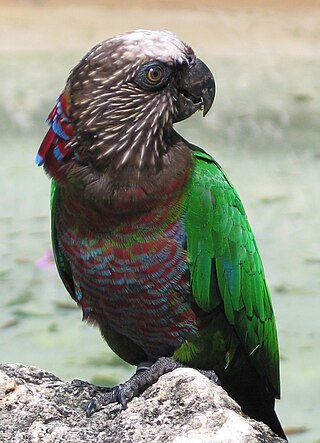
The red-fan parrot, also known as the hawk-headed parrot, is a New World parrot hailing from the Amazon Rainforest. It is the only member of the genus Deroptyus.

An aracari or araçari is any of the medium-sized toucans that, together with the saffron toucanet, make up the genus Pteroglossus.
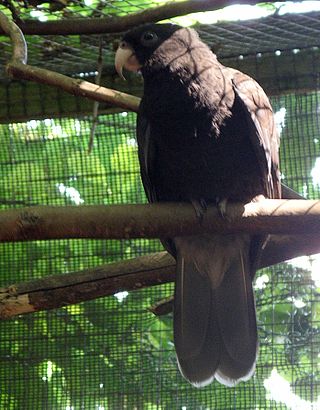
The vasa parrots that form the genus Coracopsis are four species of parrot in the Old World parrot family Psittaculidae that are endemic to Madagascar and other islands in the western Indian Ocean. Some taxonomists formerly placed the species in the genus in Mascarinus, but this is now thought to be based on the results of a heavily flawed, later-debunked genetic study.

The lesser vasa parrot or black parrot is a black coloured parrot endemic to most of Madagascar. It is one of four species of vasa parrots, the others being the greater vasa parrot, the Seychelles black parrot, and the Comoros black parrot. The latter two were formerly considered conspecific with the lesser vasa parrot.

The great-billed parrot also known as Moluccan parrot or island parrot, is a medium-sized, approximately 38 cm long, green parrot with a massive red bill, cream iris, blackish shoulders, olive green back, pale blue rump and yellowish green underparts. The female is typically smaller than the male, but otherwise the sexes are similar.

The black-lored parrot also known as the Buru green parrot, is a parrot endemic to the Indonesian island of Buru. It is a 40 cm (16 in) long green parrot with black lores, and a turquoise crown. Males have red beaks, and females are gray-brown. The singing is high pitched and more protracted as compared to similar species, such as great-billed parrot.

The blue-naped parrot, also known as the blue-crowned green parrot, Luzon parrot, the Philippine green parrot, and locally known as pikoy, is a parrot native throughout the Philippines and the Talaud Islands of Indonesia. It is threatened by habitat loss and trapping for the pet trade.

The red-billed spurfowl, also known as the red-billed francolin, is a species of bird in the family Phasianidae. It is found in Southern Africa, including Angola, Botswana, Namibia, South Africa, Zambia, and Zimbabwe.
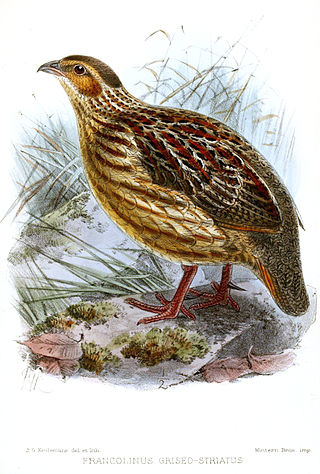
The grey-striped spurfowl is a species of bird in the family Phasianidae. It is found only in Angola.

Heuglin's spurfowl is a species of bird in the family Phasianidae. It is found in Central African Republic, Democratic Republic of the Congo, South Sudan, and Uganda. The German explorer Theodor von Heuglin first described the species.

The yellow-necked spurfowl or yellow-necked francolin is a species of bird in the family Phasianidae. It is found in Djibouti, Eritrea, Ethiopia, Kenya, Somalia, Sudan, Tanzania, and Uganda. This species is named for the yellow patch found on its neck. Males of this species have been noted to have spurs on the back of their legs.

Hydropsalis is a genus of nightjars in the family Caprimulgidae. The species are widely distributed across the tropical and subtropical regions of the New World.

The red lory is a species of parrot in the family Psittaculidae. It is the second-most commonly kept lory in captivity, after the rainbow lorikeet.
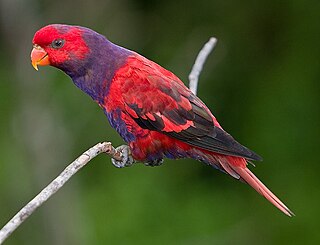
The violet-necked lory is a species of parrot in the family Psittaculidae. It is endemic to Indonesia, where it is found in the northern Maluku Islands and west Papuan islands. Its natural habitats are tropical moist lowland forests and tropical mangrove forests.

Eunymphicus is a genus of parrots in the family Psittaculidae. The genus is endemic to New Caledonia and the Loyalty Islands, and is closely related to the Cyanoramphus parakeets of Oceania.

The red-billed parrot, also known as coral-billed pionus or red-billed pionus, is a species of bird in subfamily Arinae of the family Psittacidae, the African and New World parrots. It is found in Bolivia, Colombia, Ecuador, Peru, and Venezuela.
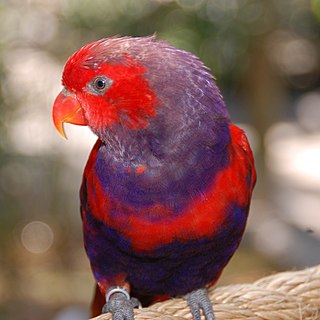
Eos is a genus of parrots belonging to the lories and lorikeets tribe of the family Psittaculidae. There are six species which are all endemic to islands of eastern Indonesia, most within very restricted ranges. They have predominantly red plumage with blue, purple or black markings. Males and females are similar in appearance.

Pternistis is a genus of galliform birds formerly classified in the spurfowl group of the partridge subfamily of the pheasant family. They are described as "partridge-francolins" in literature establishing their phylogenetic placement outside the monophyletic assemblage of true spurfowls. All species are endemic to Sub-Saharan Africa, excepted the double-spurred spurfowl. They are commonly known as spurfowls or francolins, but are closely related to jungle bush quail, Alectoris rock partridges, and Coturnix quail. The species are strictly monogamous, remaining mated indefinitely. They procure most of their food by digging. Spurfowls subsist almost entirely on roots, beans of leguminous shrubs and trees, tubers, and seeds, and feasting opportunistically on termites, ants, locusts, flowers, and fruit. Important predators are jackals, caracals, servals, and birds of prey, as well as herons and marabou storks.
























